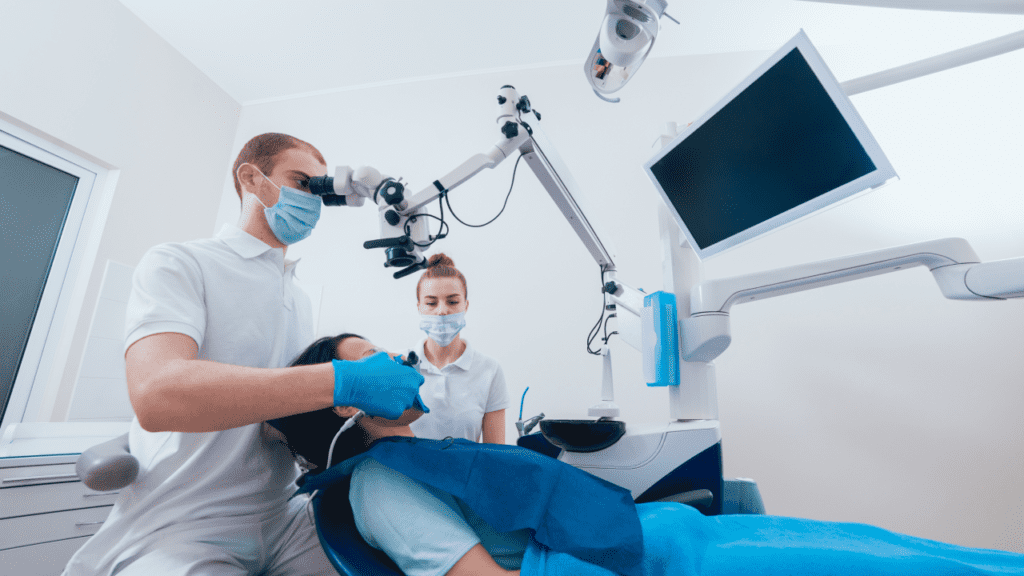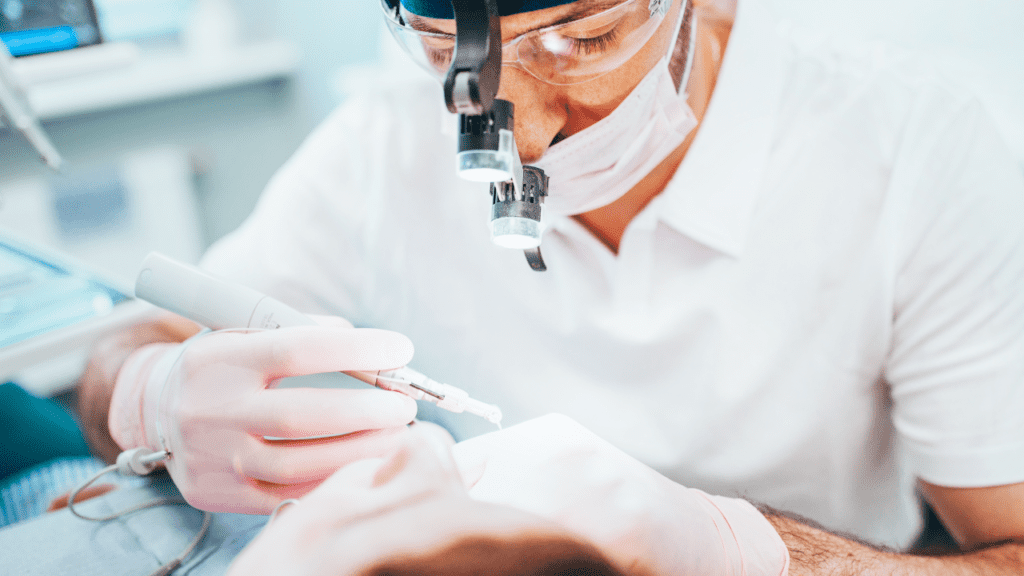Have you ever wondered why white stuff comes out of your tooth when you pry it out of your mouth? Did you know that this discharge results from your body’s natural response to tooth extraction? Here’s what you should know about tooth extraction healing white stuff and how to get your teeth back into perfect health again.
What Is the White Stuff After Tooth Extraction
The white stuff is a form of the fluid that surrounds the tooth and the bone. It is called “granulation tissue.”
The bone and tooth are separated by a soft membrane called the periodontium. This tissue is attached to the root and acts as a barrier between the outer layer of your teeth (enamel) and the inner part of your tooth (dentin). The amount of this tissue depends on factors such as how much bone was attached to the tooth, how deep the cut was made, what type of surgery you had, and how fast your body healed after surgery.
The more time passes after you have extracted a tooth, the less likely you’ll see any leftover white stuff after extraction. If there is still some in your mouth after 12 hours but not 24 hours later, then there is little chance that this material will be left in your mouth for much longer.
What Should a Tooth Extraction Hole Look Like When Healing?
The hole after a tooth extraction is often called an extraction socket. The wound can be very red and swollen, with the edges of the wound being very tender to the touch and with white gelatinous tissues. The gums around the socket may also be swollen and tender for several days after extraction or root canal treatment.
The healing process for this wound will depend on what kind of tooth extraction was done. If you had a dental crown placed over your tooth, it would take longer to heal than if you had just a simple extraction.
If your gum tissue is intact but there is still some bleeding from the cavity, it is best to apply an antibiotic ointment over the area until it stops bleeding and heals up nicely.
Should I Remove Granulation Tissue?
On tooth extraction – tissue must be removed to allow re-epithelialization to occur. Re-epithelialization can take up to three weeks, so it is important not to remove or touch the newly formed tissues until they have completely healed. If you wait too long, the chances of infection will increase, and the wound may worsen.
If your wound is large, you may need to leave it alone for a few days. However, if you can still see any signs of infection in your wound, removing the granulation tissue as soon as possible is recommended.
The procedure itself is very simple and can be done with minimal equipment:
- Gently pull back on the gum line with your fingers until you can see the root canal. This will expose bacteria that may have invaded during previous extractions or other dental procedures.
- Clean out the infected material around your tooth using a brush (or cotton swab) and an antiseptic such as betadine solution. You want to ensure that there are no remaining traces of infection in this area before proceeding further with your procedure.
- If you’ve had a tooth extraction, you’ll need to clean out any remaining dried blood from around your tooth using a brush (or cotton swab) and an antiseptic such as betadine solution.
What Is Granulation Tissue?
The granulation tissue is a specialized tissue that forms in the socket. The primary function of this tissue is to protect the underlying bone, muscle, and nerve. If the granulation tissue fails and there is no replacement to fill the space, it will form a dry socket.
This can be painful and lead to infection if not properly cared for. The most important thing you can do is remember to clean your hands after handling meat or other raw materials that could contain bacteria or other germs. Wash them thoroughly with soap and water before touching your face or eyes.
If you have a dry socket, take some time off from eating crunchy, acidic or hard food until all signs of inflammation have subsided and you feel better overall. You may also want to talk with your doctor about any other medications you are taking, including antibiotics that may cause dry sockets and other health issues such as heart disease or diabetes that can create issues with blood flow through your body.
A dry socket typically occurs within 24 hours of your procedure, often without pain. But if you experience discomfort or swelling near your mouth after removing the tooth, it may be a sign that a dry socket has formed.
You should always see your dentist immediately if you develop a sore or swollen area at or near your extraction site. The sooner you get treatment for a dry socket, the better your chance of avoiding complications like infection or abscess formation (a pus-filled sac).
The first step in treating dry sockets is removing any food particles that could be lodged between your teeth. This helps ensure that there are no bacteria or plaque behind them.
If you have a bridge or crown under your front teeth, make sure to remove any material around it before you try to remove any dry socket or bleeding. Otherwise, you may damage the bridge or crown when removing the dry socket.
What Happens if the Granulation Tissue Falls Out?
The white film on the gums is something called granulation tissue. It is a liquid that replaces the clot in the extraction site as the wound begins to heal. When you have a tooth extracted, the first thing that happens is the bleeding stops.
Then the wound starts to heal. The area around the extraction site begins to fill with granulation tissue – this is normal and what you would expect after any surgery.
If you get a cavity filled on the same day as your tooth extraction, you may not see any signs of healing for a few weeks. If this happens to you, it’s important to call your dentist immediately because it could be an emergency.
There are several reasons why the granulation tissue may fall out, including:
- The patient has had extensive tooth removal.
- The patient has had extensive dental surgery and is taking antibiotics or ibuprofen.
- There is a fracture in the tooth or gum, which could lead to infection or swelling.
- The patient has a severe case of gingivitis or periodontitis.
Signs of Infection
When the granulation tissue falls out, you risk developing a wound infection. If your wound is not healing, you may have an infection. This can lead to scarring and tissue death (necrosis). You may notice one or more of the following signs:
- Wound drainage: The wound will develop a yellowish color and ooze pus, which can be collected with a sterile gauze pad into a cup and then applied to the wound.
- Redness around the edges: A red or pink color may appear around the wound’s edges as it heals. This is normal and does not signify an infection.
- Painful movement of your hand or fingers through your hand: When your hand heals, you can move it better. However, as part of this process, there may be some pain as new tissue grows in a place where the granulation tissue fell out.
- Fever: Fever is a common symptom of infection. In the first week of bacterial infections, the fever is usually less than 101 degrees Fahrenheit or 38.5 degrees Celsius. After that, it will increase and last for 7-10 days. If you have a high fever, you should see your doctor immediately, as it can be an early sign of serious illness.
- Rash: A rash is another common sign of infection. It can be raised and red with or without bumps. It may itch and turn yellow when scratched or irritated. The rash can occur on any part of the body but most commonly appears on the face, neck, armpits, and groin areas (the area between the buttocks and thighs).
- Bulging Eyes: Bulging eyes are also a sign that something is wrong with your body because they are caused by fluid pressure inside your head that causes pressure on your brainstem and eyes (cranial nerve seven). This can lead to headaches and dizziness if left untreated.
When to See a Dentist
If you have a large cavity, it’s best to see your dentist as soon as possible. If the cavity is small and you can wait until your next visit, you can save the tooth. However, it’s important to see the dentist as soon as possible.
If the tooth becomes loose or falls out, it’s important to see a dentist immediately. If left untreated, it could lead to an infection and permanent damage.
Conclusion
Tooth extraction can cause a lot of discomfort to the patient. The wound is usually swollen and red in appearance, making it difficult to hide. In addition, there is usually a foul odor coming from the wound, which can lead to nausea or throwing up. If a tooth extraction results in injury to the jawbone and surrounding nerves, it can cause pain and numbness in the face or arm. This article has covered informative content about tooth extraction healing white stuff.
Related Articles
How Long Does Wisdom Teeth Removal Take: Everything You Need To Know
Erica Anand is a certified dental expert. She holds a BA in Chemistry and a Doctorate of Dental Surgery from Stony Brook University. After completing a two-year pediatric dentistry program, she now runs a private practice focusing on preventive dentistry and is a member of the American Association of Dental Consultants.
Marcus Ramsey has been a professional writer for over seven years. He has talked about and produced content for industries like Dentistry, Healthcare, and more.






